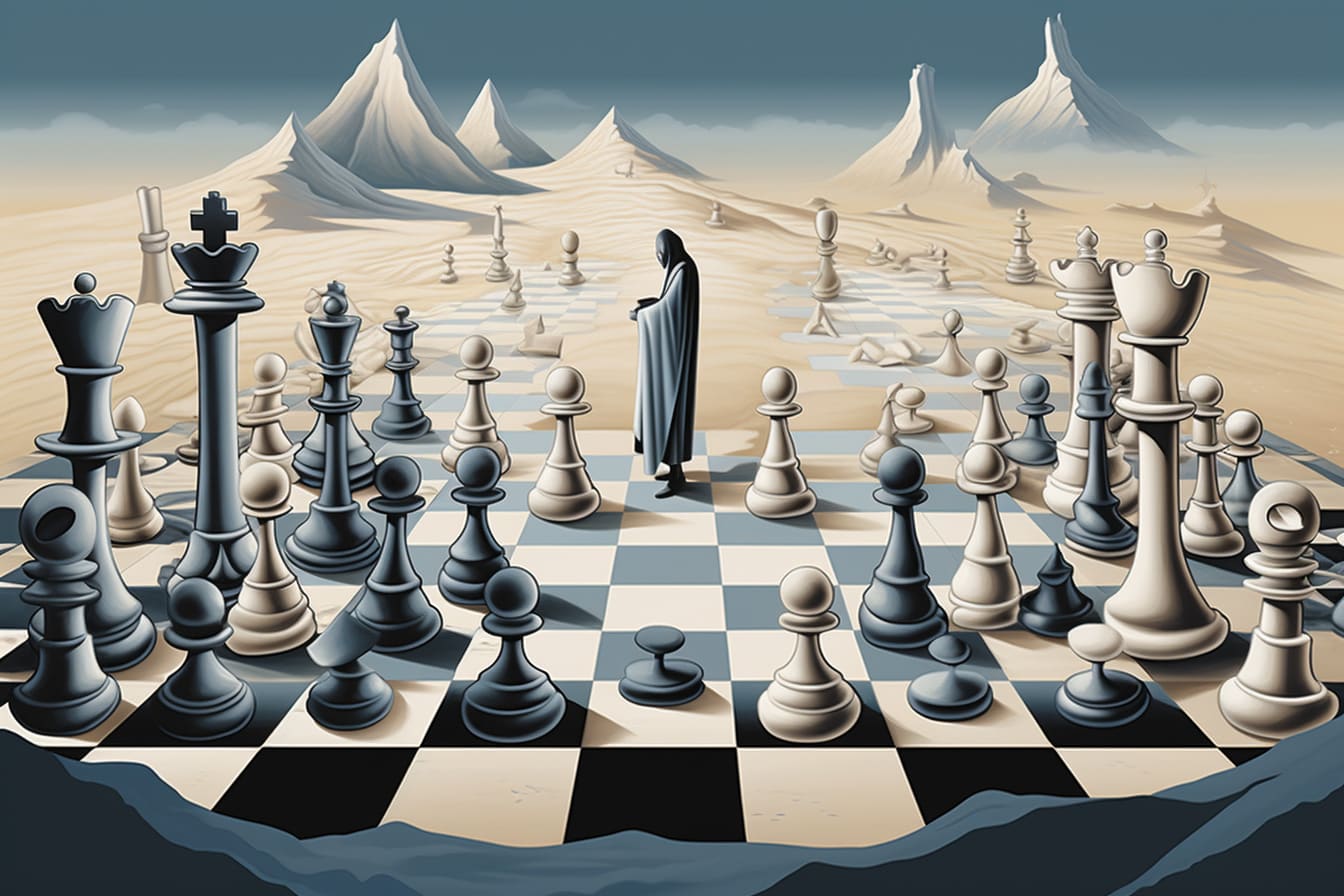I found myself standing on a square black and white board, surrounded by towering pieces. The air was thick with anticipation, and a sense of excitement filled the atmosphere. I looked down at myself and realized I had transformed into a living chess piece. I was a pawn, with a small golden crown adorning my head.
As I glanced around, I saw other people around me, each embodying different chess pieces. There were powerful knights, elegant rooks, wise bishops, and regal queens. The kings, they were nowhere to be seen, for this game was meant to be played by the pieces alone.
A voice echoed through the air, announcing the commencement of the game. The rule was simple: defeat the opposing team’s king. With that, the battlefield came to life.
I moved forward, stepping gingerly onto the next square. It was peculiar – the squares felt solid under my feet, as if they possessed their own energy. I looked ahead, strategizing my next move. I noticed a knight on the opposing side, eying me intently. Without hesitation, it charged towards me, preparing to launch an attack.
Adrenaline coursed through my veins. I had to act quickly. I dodged to the side just in time, narrowly evading the knight’s strike. I moved forward again, keeping my eyes on the board, my mind racing with possible moves.
The game was intense, each turn filled with calculated decisions. I witnessed the bishops slide across the diagonal lines, capturing opponents in their wake. The rooks roamed with power and determination, asserting their dominance over the board. The queens moved elegantly, gracefully defending their allies and attacking with precision.
As the game progressed, the battlefield lay strewn with fallen pieces, symbols of strategic choices and sacrifices made. Each move brought us closer to the inevitable moment of checkmate.
Suddenly, the chessboard itself seemed to come alive, transforming into a vivid landscape. The board, once as flat as a painting, now had depth and texture. Tall grass swayed beneath my feet, while the sky above was painted with vibrant colors. The battle had transcended mere chess, becoming a realm brimming with life’s energy.
The final moments approached, and the opposing king was within my reach. I felt the weight of the crown on my head, a reminder of the responsibility I carried. Gathering my courage, I moved decisively and cornered the opposing king, delivering the final blow.
With the thrilling sound of victory, the dream faded away. I woke up, the adrenaline of the game still coursing through my veins. The Living Chessboard Dream had transported me to a world where strategy and wit ruled, where I embodied a pawn entrusted with the power to shape the game’s outcome.
Though just a dream, its memory remained vivid in my mind. Perhaps it was a reminder of the intricacies of life, urging me to approach it with a strategic mind and a willingness to take calculated risks. And who knows, perhaps someday I would find myself on a life-sized chessboard again, ready to embrace the excitement and challenges that awaited.
The Dream, Interpreted
This dream can be interpreted as a metaphor for the challenges and dynamics of life. The black and white chessboard represents the contrast between opposing forces or choices. The excitement and anticipation suggest a significant event or a new phase in life that requires strategic thinking and decision-making.
The transformation into a pawn symbolizes a humble position or a starting point in a particular situation. The small golden crown on the pawn’s head signifies the potential for growth, recognition, or responsibility.
The presence of other people embodying different chess pieces represents the variety of individuals or roles involved in one’s life. Each piece, such as the knights, rooks, bishops, and queens, represents certain qualities or characteristics that one may encounter or possess themselves.
The objective of defeating the opposing team’s king reflects the goal of achieving a particular outcome or success in a challenging situation. This task implies the need for strategic thinking, calculated decisions, and anticipation of the opponent’s moves.
The solid and energetic sensation of the squares under the feet suggests a solid foundation or set of rules to abide by in pursuing one’s objectives. The close encounter with the opposing knight and the subsequent dodging represent the need to overcome obstacles and make quick decisions in order to progress.
The intensity and calculated nature of the game depict the serious and focused approach required in navigating through life’s challenges. The fallen pieces on the battlefield represent the sacrifices, decisions, or consequences that one may encounter along the way.
The transformation of the chessboard into a vivid landscape signifies a shift from a confined and limited perspective to a broader, more expansive view. It implies that life is not merely a game but a multi-dimensional experience filled with color, texture, and depth.
The final moments of the dream highlight the significance of staying focused and determined until the end. The successful cornering and defeat of the opposing king symbolize the accomplishment of one’s goals or the resolution of a challenging situation.
Overall, this dream suggests the importance of strategic thinking, making calculated decisions, and embracing challenges in order to achieve one’s desired outcomes in life. It may serve as a reminder to approach life’s complexities with a prepared and adaptable mindset, willing to take risks and learn from the experiences encountered along the way.
